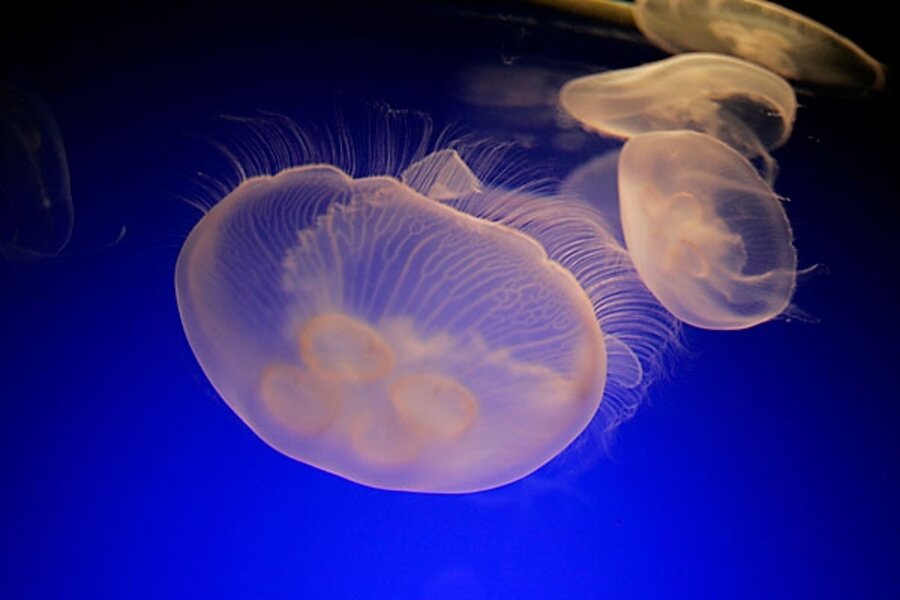How jellyfish may be stirring the ocean
Loading...
Winds do it. Ocean currents do it. And now, it looks like tiny marine creatures can do it too – act collectively as a giant Mixmaster, bringing cold, nutrient-rich water from deep in the ocean to the surface, where other marine life can use the nutrients.
A pair of aeronautic scientists say they have shown how marine organisms ranging in size from tiny copepods to shrimp-like krill to jellyfish – known collectively as zooplankton – could play a vital role in stirring up the ocean.
If they’re right, marine organisms of all sorts may be responsible for as much deep-water mixing as winds and currents. And that could have implications for conservation concerns ranging from the health of fisheries to the unanticipated effects from climate change and ocean acidification.
The new study is part of a small but growing body of research that asks not how oceans affect marine life, but how marine life affects the oceans – particularly ocean circulation.
It's a topic "that looks like it may be significant but has largely been overlooked in the past," says William Dewar, a marine scientist at Florida State University in Tallahassee who focuses on ocean circulation and was not part of the research team. The new study, he says, "is a very nice contribution."
The importance of ocean mixing
The new insights, if correct, could have implications for understanding climate change effects.
For instance, researchers from Australia have projected that if carbon-dioxide emissions continue on their present course, shell-building plankton in the Southern Ocean could reach a tipping point by 2038, due to ocean acidification. Populations could begin to drop because they are no longer able to build their protective shells.
If those creatures collectively play an important role in ocean circulation in that region, their loss would affect the regional food chain. It could also slow the up-and-down mixing of ocean water in the area, which in turn would slow the rate at which the ocean takes up carbon dioxide.
For now, such scenarios remain plausible but hard to quantify, until more scientists scrutinize the new results to see how well they hold up and, if they do, how they can be extended.
Aeronautics and jellyfish
The study was conducted by a pair of researchers at the California Institute of Technology in Pasadena. Their main focus: aeronautical engineering and bioengineering.
John Dabiri, who heads the team, had been working on propulsion issues for years, using jellyfish as his experimental subjects. Then, three years ago, marine scientists in Canada showed how plankton generated a good deal of turbulence in a coastal inlet as they migrated up and down the water column to feed. The researchers suggested that on a global scale, this could have a significant effect on ocean mixing.
Other scientists said the creatures were too small to have such an impact – that any turbulence generated by krill or plankton would quickly dissipate.
But the notion intrigued Dr. Dabiri, who did some homework and uncovered a 50-year-old theory on ocean mixing by the grandson of Charles Darwin. Mr. Darwin had proposed a mechanism in which “the organism drags the surrounding fluid as it goes.” It’s roughly analogous to pulling a spoonful of honey from a jar, with the spoon dragging along more honey beneath it.
A Darwin’s forgotten theory
Using fluid-dynamics modeling techniques unavailable 50 years ago, Dabiri and colleague Kakani Katija showed that in addition to so-called wake turbulence, Mr. Darwin's mechanism was indeed at play in the movement of these small organisms.
The efficiency of Darwin’s process, they found, depends more on the shape of the object and the thickness of the liquid than on the object's size.
In fact, the bigger the critter, the less efficient the process, Dabiri says. Where whales can drag along a volume of water perhaps one to two times their body, organisms such as krill can drag five to 10 times their body volume.
To test the results of their modeling exercises, Dabiri's team went to Palau, where they injected fluorescent dye into the water beneath jellyfish, then illuminated the dye with a laser and filmed the results. Sure enough, the jellys were seen tugging water along with them.
The videos suggest that a surprisingly large mount of water is following the jellyfish, says Dewar.
More work is needed to understand this process, the team acknowledges.
It's not clear, for example, how long the water these creatures pull up remains in the upper reaches of the ocean. And tests with smaller plankton rather than jellyfish may be needed.
"These types of experiments are so difficult," Dabiri acknowledges. "It's hard to get the animals swimming in the right location at the right time, and where the divers aren't affecting what you're measuring."





